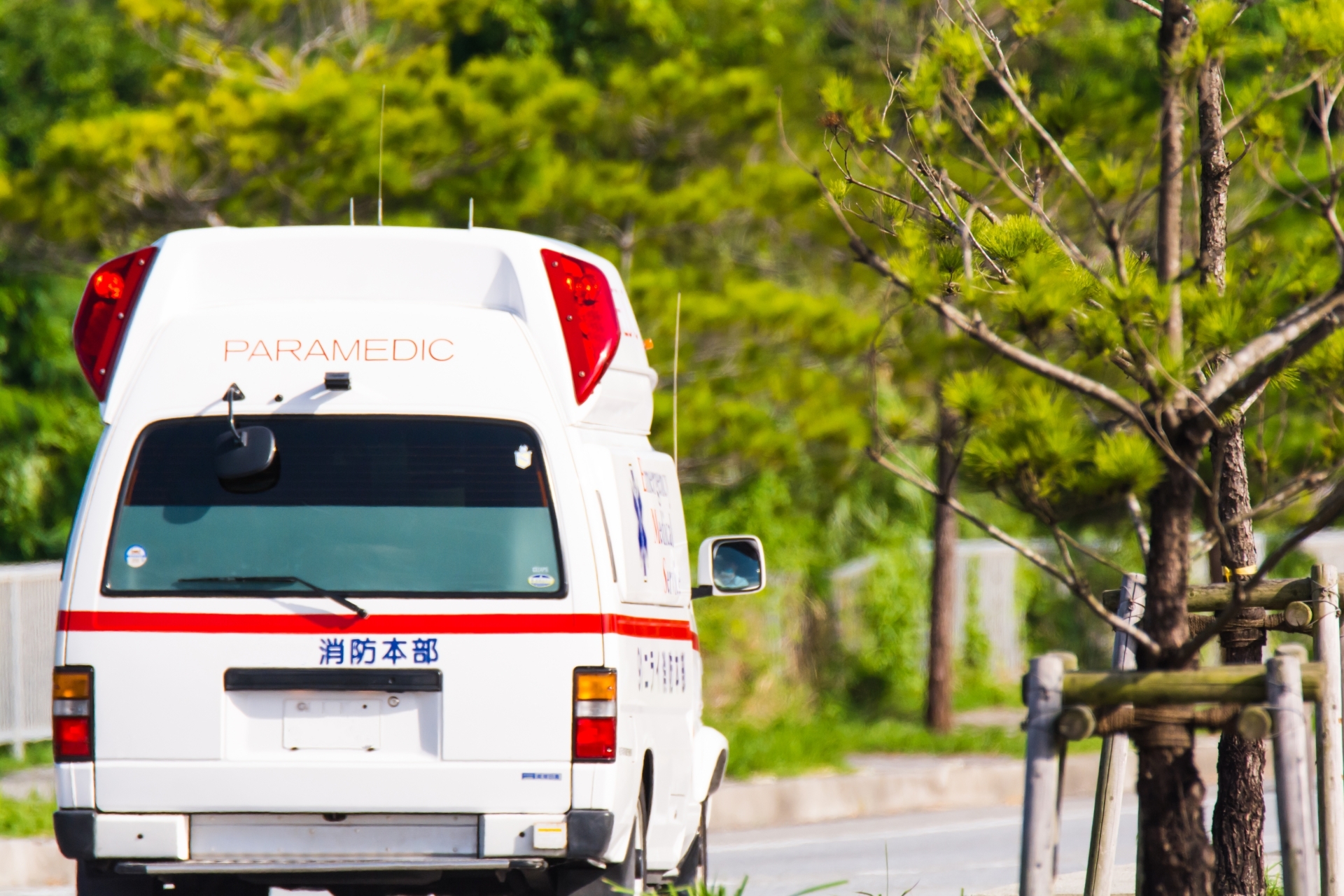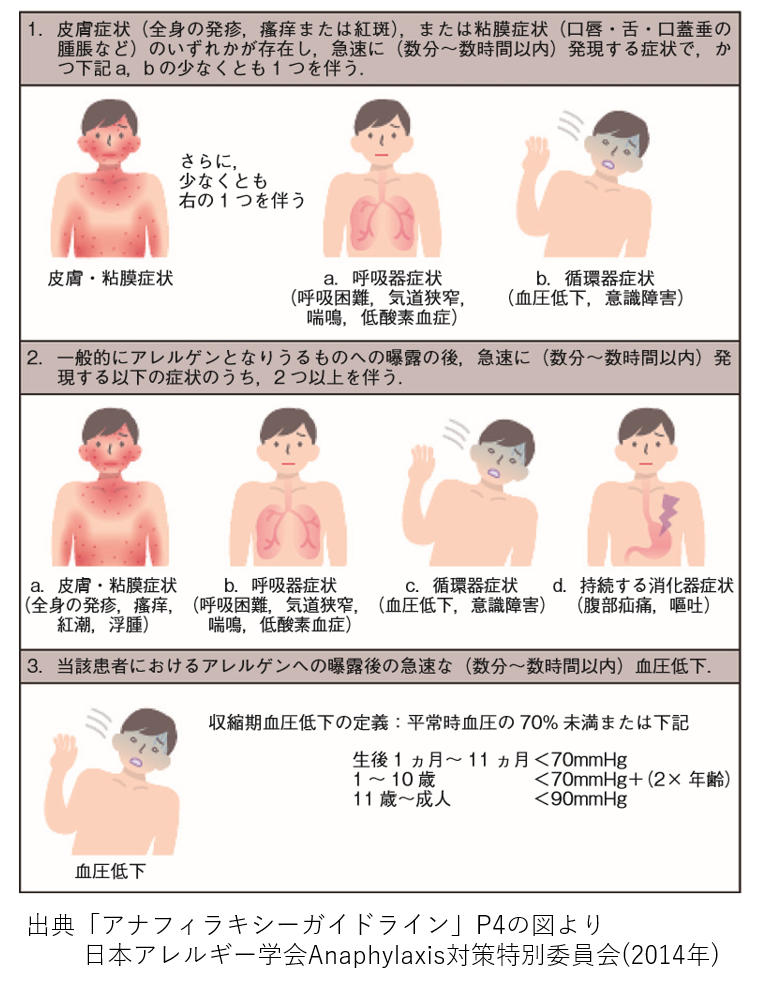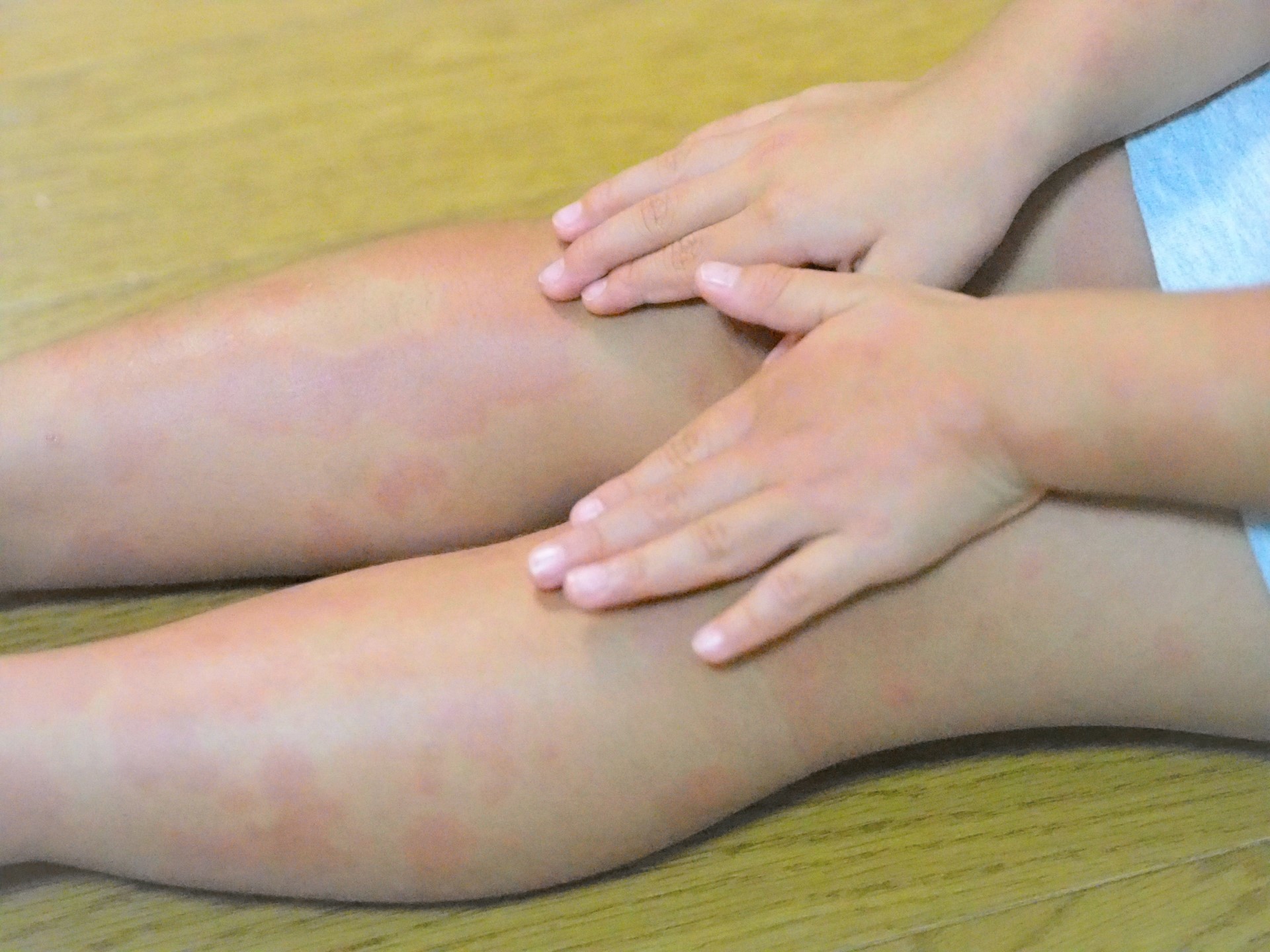What Is Anaphylaxis? What Would You Do If It Occurs? Learn Symptoms and Causes.
AlleHapi readers, have you ever heard of the word “anaphylaxis” before? Anaphylaxis is considered the most dangerous, potentially life-threatening food allergic reaction. By acquiring the basic knowledge, you can immediately take proper measure against the onset of the reaction and protect a child. This time, we will feature anaphylaxis.
What Is Anaphylaxis?
Even if you have heard the word “anaphylaxis”, do you actually understand the difference between “anaphylaxis” and “anaphylactic shock”? Firstly, let’s understand the definition of those words properly.
What is “anaphylaxis”?
Hypersensitive reactions that can be life-threatening.
Allergic symptoms occur in multiple organs due to exposure to an allergen. (* 1)
What is “anaphylactic shock”?
Anaphylaxis that is accompanied by a drop in blood pressure and loss of consciousness.
(* 1)
To simplify, when the multiple organs in the body has allergic symptoms, it is called anaphylaxis. On top of that condition, if the blood pressure falls or consciousness drops, it is called anaphylactic shock.
Either way, you need to be vigilant since both conditions could get progressively worse in an instant, causing severe symptoms that are life-threatening.
How Many People Actually Develop Anaphylaxis?
In Japan, according to the past history of students who experienced an anaphylaxis, it is reported that it was 0.6% for elementary school students, 0.4% for junior high school students, and 0.3% for high school students (* 2). In an elementary school, anaphylaxis occurs at the rate of one in about 170 children.
The probability of death caused by anaphylaxis related to food allergy is 3.25 people between the age of 0 and 19 per 100,000 patients (* 1).
So what kind of symptoms appear and what is the cause of anaphylaxis?
Symptoms Of Anaphylaxis
According to Japan allergy society, if the symptoms fall under any of the following 1 to 3, it is anaphylaxis.
Case 1: In addition to symptoms such as widespread skin rash, itching, skin redness or swelling of the lips and tongue, if cardiovascular symptoms including dyspnea, asthma, drop in a blood pressure and loss of consciousness occur, it is diagnosed as anaphylaxis.
Case 2: After the exposure to an allergen, if you develop two of the following symptoms within a few minutes to several hours, it is considered anaphylaxis.
Skin or mucous membrane symptoms: Widespread skin rash, itching, skin redness or swelling.
Respiratory symptoms: Dyspnea, narrowing of the airway and asthma. Cardiovascular symptoms: A drop in blood pressure and loss of consciousness.
Gastrointestinal symptoms: Abdominal pain and continuous vomiting.
Case 3: A drop in blood pressure within a few minutes to several hours after being exposed to an allergen.
To simplify, it is considered anaphylaxis when two sever symptoms occur at the same time. When widespread skin rash and breathing difficulties happen simultaneously or when itching and vomiting occur at the same time, it can be considered anaphylaxis. If a decrease in blood pressure and dizziness that will result in shock occur, immediate medical treatment is needed.
Cause Of Anaphylaxis
Anaphylaxis is caused by various factors. A bee sting, administration of medicine, exposure to natural rubber and environmental allergy are all considered risk factors. In this article, the causes of food-induced anaphylaxis are explained based on the guidelines of the Japanese allergy society (* 1).
The occurrence of food-induced anaphylaxis is attributed to some food such as eggs, milk, wheat, shellfish, Japanese Soba noodle, peanuts, nuts, sesame seeds, soybeans, fish, fruits. In Europe and the United States, the main causes of anaphylaxis is nuts while in Japan, eggs, dairy products, wheat, Japanese soba noodle and peanuts are known to be the main cause.
Following list shows the allergenic food that caused anaphylactic shock. Each food account for the total of 100%.
- Egg (28%)
- Dairy products (23%)
- Wheat (18%)
- Japanese soba noodle (7%)
- Peanut (5%)
- Shrimp (3%)
- Salmon eggs (2%)
- Peach (2%)
- Soybean (2%)
- Kiwi (2%)
- Banana (1%)
- Yams (1%)
- Other (6%)
When a baby starts to eat baby food, many parents pay attention to certain food including eggs, milk, wheat and Japanese soba noodle. As you can see from the list above, it is also better for the parents to be cautions when they give peaches and bananas to their baby for the first time.
In addition, there is another type of anaphylaxis that is triggered by exercising after a few hours of consuming some sensitizing food. This is called “food-dependent exercise-induced anaphylaxis”. As for schoolchildren and students, boys develop this reaction more and it shows up at about 0.0085% (1 in about 12,000 people). It is said that the reaction tends to occur during exercises that was done within 4 hours from the point when consuming sensitizing food, especially wheat products and shellfish.
When an accident of anaphylaxis occurs at public places like a school, kindergarten, it gets a lot of attention. The fact is that food-induced anaphylaxis occurs most frequently at home. When anaphylaxis symptoms develop at home, a child need immediate medical treatment. Let’s learn how to handle the situation in case it happens, so adults don’t get too upset to save their children’s lives.
What Would You Do If You Develop Anaphylaxis?
According to “Allergy Portal Site” (* 3) operated by the Japan allergy society and the Ministry of health, labor and welfare, there are measures you can take against the occurrence of anaphylaxis.(* 4).
As you read about the symptoms already, anaphylaxis is accompanied by multiple symptoms simultaneously and those symptoms develop suddenly, such as redness of the skin, difficulty breathing and vomiting. Life-threatening anaphylactic shock is likely happening if there are a drop in blood pressure and loss of consciousness.
Since anaphylaxes is a life thrashing reaction, it is recommended to administer “adrenaline self-injecting drug (epipen ®)” immediately if you have one. It is critical to call an ambulance to be transported to a medical institution. We are going to give you more detailed explanation for “adrenaline self-injected drug (epipen ®)” in a little while.
Even it doesn’t seems like anaphylactic shock, before an ambulance comes, it is recommended to inject adrenaline self-injecting drug (epipen ®) when experiencing severe asthma attacks and dyspnea.
As far as posture, it is important to lay the patient flat and position their feet higher than their head. In case of vomiting, it is also critical to keep the patient face sideways. Some doctors recommend to rinse your mouth with water if there is food left in the mouth. If some parts of your body get exposed to food that caused anaphylaxis, washing them off with water is important. (* 5).
Even though the symptoms of anaphylaxis have subsided, those symptoms may come out again after a while. Pay close attention to the patient’s physical condition and consult a doctor.
The fact is that how the anaphylaxis is treated depends on its severity. Provide the patient with basic life support if necessary and watch out for symptoms like a drop in consciousness, slowing pattern of breathing and heartbeat, and redness of the skin. Transport the patient to a medical facility as soon as possible.
アドレナリン自己注射薬(エピペン®)とは
What is adrenaline self injection (epipen ®)
“Adrenaline self-injected drug (epipen ®)” is used when anaphylaxis occurs. Before the patient receives a physician’s treatment, It temporarily relieves the progress of the symptoms and prevents anaphylaxis shock from happening (* 6). Its effects are immediate, and it strengthens the faction of the heart that result in an increase in blood pressure and expands the bronchi that leads to smooth breathing. (* 7).
It looks like a pen that can be carried around easily and is designed in a way that allows patient to administer adrenaline smoothly. In case of a child, since it is difficult for the child to inject it. Adults tend to administer it to the child. It is important for not only parents, but other adults who are closet to the child to know how to inject the medicine correctly.
If a child develops anaphylaxis at public places including a kindergarten, day care, and schools, there is a possibility that teachers and school staff must inject epipen ®to the child. Therefore, various guidelines of allergies and anaphylaxis such as “nursery school guidelines” and “school’s allergy disease guideline” are available. Teachers are trained and have knowledge of anaphylaxes through study sessions and training.
Epipen ® is not a primary treatment and how to use it is normally explained and prescribed by a doctor. It is very important to remember that it is necessary to receive medical treatment by a doctor immediately after injection of epipen ®.
To Prevent Anaphylaxis
When anaphylaxis occurs, the patient suffers the most, but at the same time, people who witness it tend to panic as well. It is critical to know how to prevent anaphylaxis. At the end of this article, three effective measures to prevent anaphylaxis are introduced.
Paying attention when introducing the baby to baby food for the first time
From a baby’s stand point, everything is a “first time” when weaning food starts. It is often said that a teaspoon of baby food should be given. If you are still anxious, you can give your baby even smaller amount of food.
If possible, let your baby try food for the first time in the morning on the weekdays. If anything goes wrong, you can see a doctor immediately since there are many medical institutions that are open on weekdays in the morning.
Even if your family members have food allergies, that does not mean all the family members are allergic to the same food. If you are concerned, it is recommended that you consult your doctor beforehand.
Identifying specific food · do not eat (do not touch)
If you are concerned, you can have your doctor identify the type of food that trigger allergy. With a consultation by an allergist, It is done through certain test including blood test and oral food challenge test.
Once a patient develop anaphylaxis once, a physician normally recommends the patient to avoid specific food that caused the reaction to prevent the relapse. There is a case where anaphylaxis occurs just by touching the food that case the allergy. So, it is important not to touch the food.
In recent years, research on food allergy has progressed and various treatment methods have been developed. In contrary to a conventional treatment of avoid eating allergenic food, with their doctor’s help, recently developed oral immunotherapy allows patient to eat small amount of the allergenic food without causing a reaction. (* 8). If you are interested in it, please consult with your doctor.
Have people in the neighbor know
To avoid an accident, if you already know the type of food that cause anaphylaxis for your child, let people know the facts like “My child has food allergies” and “There is a possibility of anaphylaxis if my child consume this food”.
Sometimes there are people who want to hide the fact that their child has allergy. However, in order to protect your child, it is important to have people understand what your child is dealing with. If they know, they can help the child avoid allergenic food and can pay extra attention to what kind of snacks they can give to the child. Food provided by kindergartens and schools is allergy friendly. It is also important for not only teacher and public health nurse but also classmate to know the fact that your child has allergy.
How was it?
When anaphylaxis occurs, it is important to deal with it calmly. In order to do that, it is important to obtain knowledge in advance and prepare for the unforeseen circumstances. Our site AlleHapi will continue to provide our readers with useful allergy information.
References
※ 1: “Anaphylaxis Guidelines” In 2014, The Japanese allergy Society: Anaphylaxis Special Committee https://anaphylaxis-guideline.jp/pdf/guideline_slide.pdf
* 2: “Interim Report On” Health Management In School “ In 2013, Document Of A Survey Research On Food Allergy Management Of School Lunch (Ministry of Education, Culture, Sports, Science and Technology)
http://www.mext.go.jp/b_menu/houdou/25/12/__icsFiles/afieldfile/2013/12/19/1342460_1_1.pdf
※ 3: “Allergy Portal” Japanese Society Of Allergology, Ministry of Health, Labor and Welfare https://allergyportal.jp/
※ 4: “Allergy Portal” “Allergy Countermeasures Anaphylaxis” Japanese Society Of allergology, Ministry of Health, Labor and Welfare https://allergyportal.jp/provision/anaphylaxis/
※ 5: “When Anaphylaxis Happens” “What Is Anaphylaxis? “Mylan EPD Joint Venture Company https://allergy72.jp/anaphylaxis/treatment.html
※ 6: “For Patients And Families Prescribed Epipens” “ What Is Epipens” Mylan EPD Joint Company · Maylan Pharmaceutical Co., Ltd. https://www.epipen.jp/about-epipen/photo.html
※ 7: “Knowing Food Allergies In Meiji Era” “ Learn Food Allergies. What Is Anaphylaxis?” Meiji https://www.meiji.co.jp/meiji-shokuiku/food-allergy/about/02/
※8: “Oral Immunotherapy” Sagamihara National Hospital http://www.hosp.go.jp/~sagami/sinryouka/syounika_keikoumeneki.html



